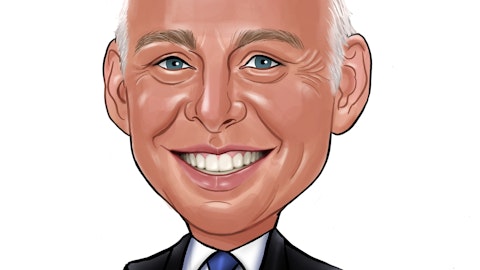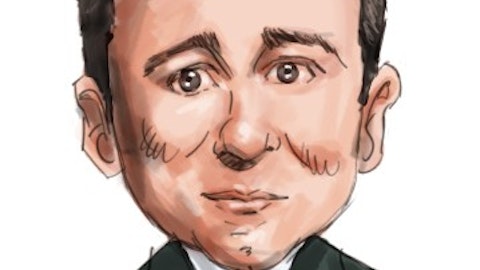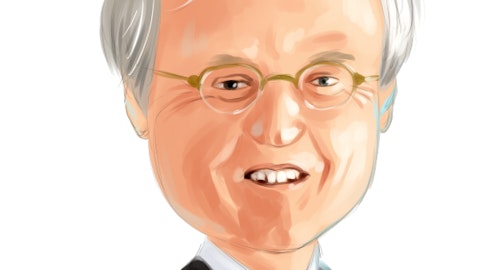Ron Farnsworth: Good morning.
Brandon King: Yes. So I wanted to get a sense of what your assumptions are for deposit mix shift so in the quarter that were outflows from DDAs into interest-bearing, I saw there’s uptick in CD deposits. So I just want to get a sense of what your assumptions are there in your current CD strategy?
Ron Farnsworth: Brandon, this is Ron. You say assumptions you’re talking about just in terms of our interest rate sensitivity analysis?
Brandon King: No, just like where do you see — do you see continued further remixing of DDA accounts into interest-bearing accounts going forward?
Ron Farnsworth: Got it. Yes, I would — it’s hard to say, a specific percentage from that standpoint. What we saw here in the fourth quarter is, like on the consumer about two-thirds of the decline in DDA was on the consumer side, about a third on the business side with the consumer side, it was simply the trends incomes were relatively flat but outflows were up 10-ish percent. And so you’ll see that decline. So it’s hard to say if that’s going to continue at that level. I think there will still be pressure on deposits and the industry as the Fed’s tightening on the commercial side, it’s probably a little bit of mix and some sparing. I would expect, we have used some exception pricing from a pricing just hold-on to larger balance more cost-sensitive deposits.
I would expect that would continue here into Q1 as well. So net-net, you probably should see an increase in more interest-bearing and it’s the trends on the ACA side continue in the industry that’s specific just two aspects. But we see continued pressure on DDA mix.
Brandon King: Got you. And– if the current CD strategy to kind of term out these time deposits, are you looking for more shorter-duration funding.
Ron Farnsworth: On the CD side it would be generally between six and 12 months in that standpoint. On the borrowing side, we’ve been in the two to four month range, just given LCR considerations.
Brandon King: Okay. And then wanted to dig a little deeper into loan growth multifamily has been a key contributor for a while now. Just curious what the outlook there is for multifamily growth in as far as how demand is looking and then also in consideration of other banks kind of seems like there might be pulling back from this space given concentration concerns.
Tory Nixon: Yes, Brandon, this is Tory. I think the multifamily business for us is — it’s pretty complicated. In this regard, we do a lot of multifamily lending in our real-estate group, and then we have a specific multifamily division. And that specific multifamily division is where you saw, we’ve seen a lot of growth over in 2022. We have– that’s really demand for that. It’s very interest-rate sensitive, so demand for that product is much less than it was historically in 2021 and 2022. So it’s relatively flat for us. We continue to be active in this space where we can and we continue to be active in the multifamily space in our real estate division. So larger projects. And I see the outlook there to be relatively flat for over the coming six to nine months.
Brandon King: Okay. Very helpful. Thanks for taking my questions.
Tory Nixon: Thank you.
Operator: Thank you. And we have a question from Andrew Terrell with Stephens. Your line is open.
Andrew Terrell: Hi, good morning. Maybe you can go back to just the DDA balances specifically on kind of the consumer side. I would be curious as you look at kind of consumer accounts that your bank, if balances today still remain elevated compared to pre-COVID levels, I’m just trying to get a sense of if there still kind of any surge deposits remaining in the bank or any type of analysis you’ve done there.
Ron Farnsworth: Andrew, this is Ron. It’s difficult to give a specific beat on it. Just given the trends and outflows, but obviously they lower. Just hard to identify, just given the cash is fungible right, let’s still considered surgery was not. I would say this though, when you think back to where the bank was five years ago, 10 years ago, three great recession, obviously much lower DDA mix. but one of the key items here that, keep in mind, and while I don’t expect the mix to revert back to those levels over-time, it’s just a significant business mix shift and changes that Cort and Tory made over the last decade. So, much higher-level of commercial balances within the deposit book today which will give us some stability. I think right now what you’re seeing is, just real instantaneous reactions just with the Fed tightening and inflation on the consumer side, so that continues.
I expect that also continue in terms of outflows in DDA. But overall, nowhere near where it was decades plus back, just given the mix-shift with the customers.
Andrew Terrell: Yes. That’s a good point. I appreciate that. And if I can maybe go back to just the mortgage commentary for a moment. I realize it’s probably tough to think about the go-forward kind of mortgage contribution as a percentage of fees or revenue but can you just maybe talk about specifically, post some of the actions that you’re going to take. And maybe shifting towards the more retail mortgage business. I guess, just structurally, how does that change the profitability within your mortgage business going-forward.
Cort O’Haver: Hi, Andrew, it’s Cort. So traditionally, until 2022, we had operated mortgage group home lending as we call it, it’s more of a traditional first mortgage operation company, if you will. And obviously with rates doing what they did and with the movement we saw, we’re going to transition to more of a retail model, what do we mean by that are in-place mortgage lenders and retail locations operating in support of their local communities and the branches. That’s what that generally has traditionally met which is a change for the way that we have served our local markets. To your point, it’s hard at this point to give any indication of where we think volumes are going to be and it has a lot to do just with just volumes in the communities and under themselves alone, where we get with staffing.
Staff, I’ll Tory comment a little bit on where you think staffing will settle out. And this is all done, we’re making these moves right now, actually since the beginning of the year. We’ll make them during the quarter. So, Tory some guidance on FTE.



